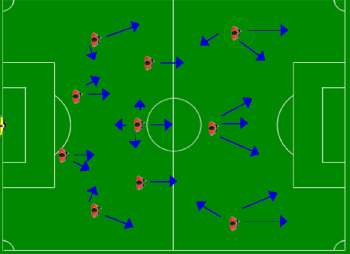Learn the basic ideas of the 4-3-3 Soccer Formation
This attacking formation has been used by national sides of Brazil (62), and more recently Portugal and Holland. Amongst the more notorious of coaches it has been effectively deployed by Jose Mourinho, Zdenek Zeman and Jesualdo Ferreira and Ajax, Rosenborg and Chelsea are included in the many club sides that have used this system of play. So what is it, how is it normally used, what benefits does it have, and what are its draw backs?
4 3 3 Set Up
4 – 3 – 3 is normally set up in the following line up: Goalkeeper, Right back, 2 Centre backs, Left back, 3 Central midfielders (one holding), 3 Attackers including a Right and Left wing and a central striker.
 This formation favors teams boasting a good central defensive midfielder who is able to hold their position, disrupt the oppositions attack and maintain possession offering support in front of the defensive line and support behind the two other central midfielders and attackers. The defensive central midfielder should be able to read the phases of play effectively and have good awareness of passing options and they must be disciplined in maintaining and organizing shape, balance and depth to their team.
This formation favors teams boasting a good central defensive midfielder who is able to hold their position, disrupt the oppositions attack and maintain possession offering support in front of the defensive line and support behind the two other central midfielders and attackers. The defensive central midfielder should be able to read the phases of play effectively and have good awareness of passing options and they must be disciplined in maintaining and organizing shape, balance and depth to their team.
Wingers in the 4-3-3
Teams that use the 4 – 3 – 3 formation typically have 2 lively wingers who provide width in attack and defensive support when not in possession. The 2 wingers should like to run with the ball and like to dribble but in addition should they be comfortable dropping back to support the defensive line when needed. The wing position in this formation can be a physically demanding role and also demands a high quality end product so its effectiveness can be limited by the personnel a coach has available.
Central Striker in the 4-3-3
The central striker can play several roles in this system depending on their strengths as an individual and the tactics and weaknesses of the opposition back line. Some use the striker as ‘touch the net’ player who will create depth to the side making their runs between the 2 centre backs and keeping these 2 players occupied. This creates space for the 2 wingers to attack the full backs in 1 on 1 situations. Using this ‘touch the net’ run creates an immediate outlet when possession is regained and suits a strong robust striker.
One potential drawback with the 3 attackers
One potential drawback with the 3 attackers occurs when the ball is switched to the wide players and the central player can become isolated in and around the penalty area when the cross is delivered. In this scenario it is imperative that the opposite winger joins the central striker in the danger areas as does at least 1 of the two attacking midfielders, whilst the other attacking central midfielder will look for pull backs and knock downs a little deeper than the attacking runs which are higher up into the penalty area.
What if the opposition holds their defensive line high up
If the opposition back four hold their defensive line high up the pitch and do not allow the central striker to create depth then a combination of the striker coming short to draw a centre back further up field, the two wingers keeping wide to stretch the back line and forward runs form the 2 attacking midfielders beyond the defensive line can be used to open the defense. If in this scenario the centre back does not follow the striker then the striker can turn on the ball and play through to either attacking centre midfielder or behind the full backs for the wingers to attack. Due to the numbers of players who can become involved in the attacking third this system of play can become a very attacking formation.
The Back Four
The back four essentially play a traditional role when not in possession denying space and pressurizing in key areas but with the defensive central midfielder on hand to help with 2nd balls and compacting the oppositions midfield play. For more information on defensive shape and organization please refer to the forthcoming articles on defensive principles. When in possession and the ball has switched wide to winger the opposite full back should push forward to fill the space left by his own winger who will make attacking runs inside to support the central striker. As this occurs the defense will slide across to maintain balance and shape.
Key to a successful 4-3-3 formation
When not in possession the 4 – 3 – 3 formation almost becomes a 4 – 5 – 1 system as the 2 wingers should ‘sag’ back in to the middle third to compact the opposition’s midfielders. If the opposition is playing a 4 – 4 – 2 system there is also opportunity to press for the ball higher up the pitch in the attacking third. This can force the opposition to play more directly through to their forwards and allow more chances to regain possession. The key to a successful 4 – 3 – 3 formation occurs in the moment of transition in play between the opponents possession and regaining the ball. Immediately possession is gained the team must be prepared to create width, depth and support at pace and can sometimes be seen as a counter attacking tactic against strong teams.
